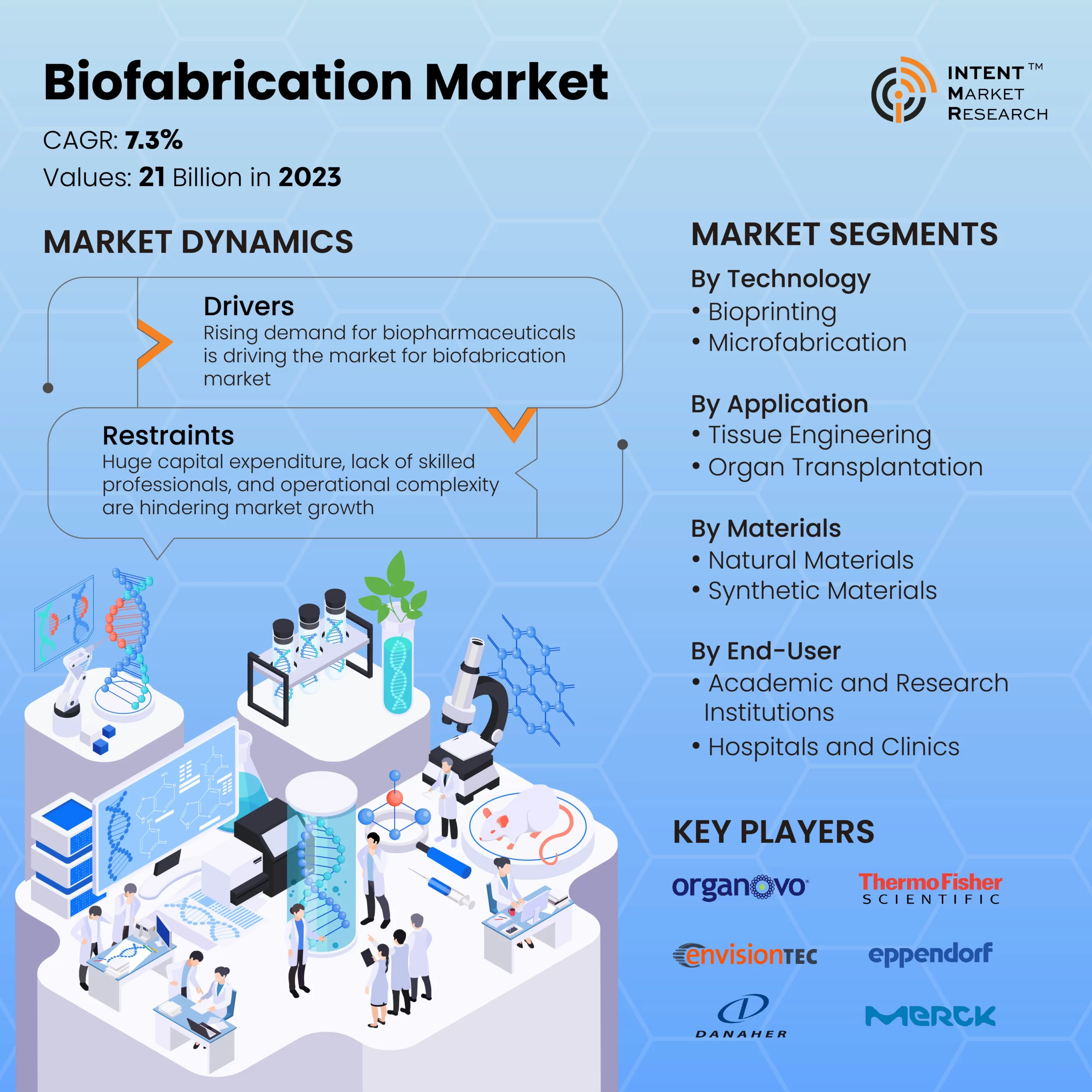Biofabrication Market
- December, 2023
- LifeSciences and Healthcare
Biofabrication Market Size Analysis by Technology (Bioprinting and Microfabrication), by Application (Tissue Engineering, Organ Transplantation, Disease Modeling, Drug Development), by Materials (Natural Materials and Synthetic Materials), by End-User (Academic and Research Institutions, Biotechnology and Pharmaceutical Companies, Hospitals and Clinics) and by Region; Growth Trends & Forecasts (2024 - 2030)
As per Intent Market Research, the Biofabrication market size is expected to grow from USD 21 billion in 2023 to USD XX billion by 2030, at a CAGR of 7.3% during the forecast period (2024-2030). The Biofabrication market is segmented by technology, application, materials, end-user, and region.
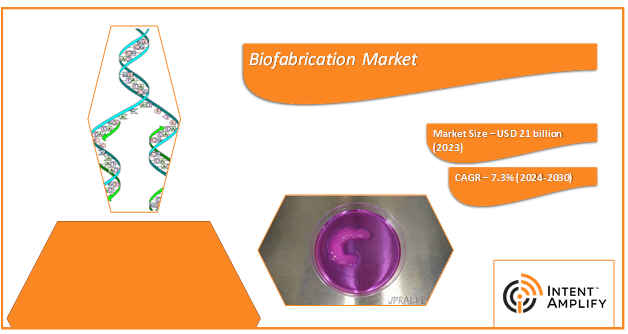
Biofabrication is an innovative field at the intersection of biology, engineering, and materials science. It involves the use of additive manufacturing (3D printing) and other advanced techniques to create biological structures, tissues, and even entire organs using a combination of living cells, biocompatible materials, and biomolecules. Biofabrication technique is used in variety of applications including regenerative medicine, tissue engineering, drug testing, and disease modeling.
Biofabrication methods offer significant advantages such as the ability to monitor the printing process using sensors. This allows online quality monitoring, resulting in reproducible printing results with high shape-fidelity, printing resolution, and cell viability. By integrating sensors and quality assessment, standardized manufacturing platforms can be developed. Along with robotic process automation, this makes it possible to scale up the production of clean meat or Organs-On-Chips (OoCs) through Biofabrication. Real-time recording of sensor data and rigorous quality control are essential for certifying Advanced Therapy Medicinal Products (ATMPs), playing a pivotal role in obtaining approval for clinical applications.
Rising demand for biopharmaceuticals is driving the biofabrication market
Biofabrication is a crucial process for drug testing and clinical trials and expected to reduce the need for animal testing, making it both ethical and cost-effective. In the past, clinical trials for new drug development required testing on animals with artificially-induced affected tissues. Biofabrication techniques enable drug developers to swiftly identify potential complications linked to human clinical trials of new drugs, significantly minimizing losses incurred during late-stage failures.
Biofabricated organs help identify the side effects of drugs, helping developers streamline safe drug dosages for humans. This technology allows for quick drug discovery, and as of early 2022, there are 11,351 drugs in the pre-clinical phase of R&D, according to Pharma Intelligence. The US Food and Drug Administration regulatory agency is considering alternatives for drug safety and efficacy assessment, providing further scope for the market. Companies such as Organovo, which is based in the US, have played a vital role in developing a 3D bioprinter to create liver and kidney tissue for drug discovery applications.
Huge capital expenditure, lack of skilled professionals, and operational complexity are hindering market growth
Biofabrication facilities require high initial investments in specialized equipment, materials, and infrastructure, which is a barrier, especially for smaller research institutions or companies. The cost is unpredictable due to the need for continuous innovation and research. Biofabrication, a multidisciplinary field demanding expertise in biology, engineering, and materials science, faces a shortage of skilled professionals.The complexity involved in biofabrication processes poses operational challenges and compatibility issues. Achieving the desired properties in the fabricated tissues or organs requires a deep understanding of material interactions and biological processes. Due to high capital expenditure, unpredictable costs, a shortage of skilled professionals, operational complexity, and compatibility challenges, the growth of the biofabrication market faces hindrances.
Rising demand for Bioprinting techniques is thriving the market growth
The growth of medical tourism in European countries is being driven by the ability of 3D Bioprinting to reduce drug reactions and expand treatment options. In an effort to improve healthcare infrastructure, the UK government invested USD 70 million in the industry strategy challenge fund. Three treatment centers for advanced therapy have also been established for advanced precision and gene therapy. The healthcare industry is being revolutionized by artificial intelligence, which is making it easier for healthcare professionals to monitor and track clinical data, thereby reducing errors.
In August 2020, AstraZeneca plc and Renalytix AI plc introduced strategies for the use of 3D bioprinting in the treatment of metabolic, renal, or cardiovascular diseases. Researchers at Seoul National University Hospital & College of Medicine have also developed an algorithm called Deep Learning Automatic Detection that analyzes chest radiographs to identify abnormal cancer growth. The market for 3D bioprinting experiences growth propelled by AI advancements.

Increasing demand for biofabrication techniques in tissue engineering is responsible for market growth
Biofabrication constructs complex 3D tissues and organs using biocompatible materials and living cells. These advanced techniques in tissue engineering allow for the tailoring of tissues and organs to individual patients, improving compatibility and effectiveness while reducing the risk of immune rejection.
Advancements in 3D printing and biomaterials improve the precision and feasibility of biofabricated constructs, serving as valuable models for studying diseases, drug testing, and regenerative therapies. Biofabrication holds promise in clinical applications such as wound healing, reconstructive surgery, and implants for various medical conditions. Ongoing advancements will result in the development of increasingly sophisticated bioengineered tissues and organs for clinical applications.
The market for regenerative medicine and tissue engineering is growing due to the increasing number of clinical studies being conducted in this field. As per the clinicaltrials.gov website, there are approximately 58 studies related to regenerative medicine and 63 studies focusing on tissue engineering currently underway.

Synthetic materials create scaffolds that support cellular growth, and tissue formation driving market growth
Synthetic materials are essential in tissue engineering. They can be engineered to exhibit specific properties, allowing researchers to tailor the characteristics of biomaterials to meet specific requirements. Many synthetic materials such as Polymers, Polyurethane (PU) & Polycaprolactone (PCL) are biocompatible, possess superior mechanical properties, and can degrade at controlled rates. They offer a wide range of options, making them suitable for widespread use in tissue engineering and biofabrication. Synthetic materials are used in biofabrication to create structures that support the growth of living cells and tissues. These include polymers such as PLA, PGA, PCL, and PEG, synthetic hydrogels such as PEGDA and PNIPAAm, and synthetic ceramic materials such as hydroxyapatite and tricalcium phosphate. These materials are combined with living cells and bioactive molecules to create scaffolds that support tissue growth and development.

Biotechnology and pharmaceutical companies are the major revenue contributors
Biotech and pharma firms heavily invest in R&D for advanced techniques, allowing the creation of human physiology-mimicking tissue models in biofabrication. This approach reduces both costs and time in drug testing.They explore producing tissues/organs for transplantation, addressing organ shortages, and developing regenerative therapies. Companies take promising research from labs to market, collaborating with others to leverage resources. They fund biofabrication startups, pursue patents, and translate research into products, driving tech advancements and market growth. For instance, in June 2022, REGEMAT 3D and Humabiologics partnered to serve a wider customer base in the European Bioprinting and drug testing market.

Technological advancement & new product launches are the key strategies adopted by major market players in North America
North America dominate the biofabrication market owing to advanced technology that enables the diagnosis and treatment of chronic disorders. In addition to that the availability of private and government funding, and high healthcare spending is expected to fuel the market growth. Advancements in 3D tissue engineering technology and technological advancement will boost the new product development in biofabrication market. For example, in April 2022, Organogenesis, a leading company in regenerative medicine, presented the latest advancements in their wound care research at the 2022 Symposium on Advanced Wound Care Conference held in Phoenix, Arizona. Their focus was on products such as PuraPly AM, Affinity, Apligraf, and Organogenesis Physician Solutions.
The mergers & acquisitions by major players are driving the biofabrication market growth
Biofabrication market is fiercely competitive, with numerous manufacturers vying for a significant share. Market participants employ essential strategies such as product launches, approvals, acquisitions, and innovations to sustain and expand their global presence. For instance, In January 2023, BioMed X and AbbVie extended their research partnership with a focus on immunology and tissue engineering. Prominent players include Danaher, Merck KGaA, Organovo Holdings, Thermo Fisher Scientific, and Sartorius Stedim Biotech.
Biofabrication Market: Scope of the Report
The report provides key insights into the biofabrication market, and it focuses on technological developments, trends, and initiatives taken by the government. In this sector, analysis explores market drivers, restraints, opportunities, and other relevant factors The report analyzes the market for biofabrication, including key players and competitive landscape.
Biofabrication is segmented by Technology (Bioprinting and Microfabrication), by Application (Tissue Engineering, Organ Transplantation, Disease Modeling, Drug Development and Others), by Materials (Natural Materials and Synthetic Materials), by End-User (Academic and Research Institutions, Biotechnology and Pharmaceutical Companies, Hospitals, and Clinics and Others) and by Geography (North America, Europe, Asia -Pacific, Latin America, Middle East & Africa). The report offers the market size and forecasts for the biofabrication market in value (USD billion) for all the above segments.
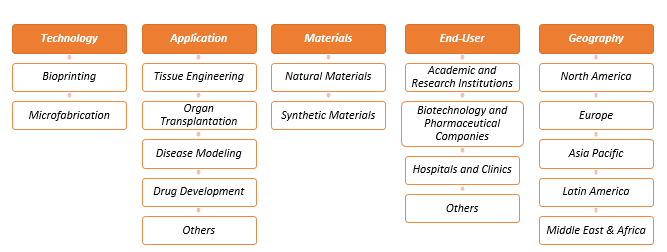
Report Scope
Report Features | Description |
Market Value (2023) | USD 21 Bn |
Forecast Revenue (2030) | USD XX Bn |
CAGR (2024-2030) | 7.3% |
Base Year for Estimation | 2023 |
Historical Period | 2022 |
Forecast Period | 2024-2030 |
Report Coverage | Revenue Forecast, Market Dynamics, Competitive Landscape, Recent Developments |
Segments Covered | by Technology (Bioprinting and Microfabrication), by Application (Tissue Engineering, Organ Transplantation, Disease Modeling, Drug Development ), by Materials (Natural Materials and Synthetic Materials), by End-User (Academic and Research Institutions, Biotechnology and Pharmaceutical Companies, Hospitals and Clinics ) and by Region (North America, Europe, Asia -Pacific, Latin America Middle East and Africa) |
Regional Analysis | North America (US, Canada), Europe (Germany, France, UK, Italy & Rest of Europe), Asia Pacific (China, Japan, South Korea, India, and rest of Asia Pacific), Latin America (Brazil, Mexico, Argentina, & Rest of Latin America), Middle East & Africa (Saudi Arabia, South Africa, United Arab Emirates, & Rest of MEA) |
Competitive Landscape | Thermo Fisher Scientific, Danaher, Merck KGaA, Sartorius Stedim Biotech, Eppendorf, Envisiontec, Organovo Holdings, Inventia Life Sciencek, Poietis, Vivax Bio, Allevi, Cyfuse Biomedical K.K, 3D Bioprinting Solutions, Cellink Global and Regemat 3D S.L. |
Customization Scope | Customization for segments, region/country-level will be provided. Moreover, additional customization can be done based on the requirements. |
Purchase Options | We have three licenses to opt for Single User License, Multi-User License (Up to 5 Users), Corporate Use License (Unlimited User and Printable PDF) |
1. Introduction |
| |
1. 1. Study Assumptions and Biofabrication Market Definition | ||
1.2. Scope of the Study |
| |
2. Research Methodology |
| |
3. Executive Summary |
| |
4. Biofabrication Market Dynamics | ||
4.1. Market Growth Drivers |
| |
4.2 Market Growth Challenges |
| |
5. Biofabrication Market Outlook | ||
5.1. Investment & Funding Analysis | ||
5.2 Future Perspectives for Biofabrication | ||
5.3. Production Outlook |
| |
5.4 Regulatory Scenario Analysis | ||
5.5. Emerging players in the industry 5.6 Pestle Analysis 5.7 Porters Five Forces 5.8 BCG Matrix Analysis 5.9 Patent Analysis 5.10 Value Chain Analysis | ||
6. Global Biofabrication Market Segmentation (Market Size and Forecast by Value – USD billion, 2023 – 2030) | ||
6.1 Technology |
| |
6.1.1 Bioprinting |
| |
6.1.2 Microfabrication |
| |
6.2 Application |
| |
6.2.1 Tissue Engineering |
| |
6.2.2 Organ Transplantation |
| |
6.2.3 Disease Modeling |
| |
6.2.4 Drug Development |
| |
6.2.5 Others |
| |
6.3 Materials |
| |
6.3.1 Natural Materials |
| |
6.3.2 Synthetic Materials |
| |
6.4 End-User |
| |
6.4.1 Academic and Research Institution | ||
6.4.2 Biotechnology and Pharmaceutical Companies | ||
6.4.3 Hospitals and Clinics |
| |
6.4.4 Others |
| |
6.5 Geography |
| |
6.5.1 North America |
| |
6.5.2 Europe |
| |
6.5.3 Asia-Pacific |
| |
6.5.4 Latin America |
| |
6.5.5 Middle East and Africa |
| |
7. North America Biofabrication Market Segmentation (Market Size and Forecast by Value – USD billion, 2023 – 2030) | ||
7.1 Technology |
| |
7.1.1 Bioprinting |
| |
7.1.2 Microfabrication |
| |
7.2 Application |
| |
7.2.1 Tissue Engineering |
| |
7.2.2 Organ Transplantation |
| |
7.2.3 Disease Modeling |
| |
7.2.4 Drug Development |
| |
7.2.5 Others |
| |
7.3 Materials |
| |
7.3.1 Natural Materials |
| |
7.3.2 Synthetic Materials |
| |
7.4 End-User |
| |
7.4.1 Academic and Research Institution | ||
7.4.2 Biotechnology and Pharmaceutical Companies | ||
7.4.3 Hospitals and Clinics |
| |
7.4.4 Others |
| |
7.5 Country |
| |
7.5.1 United States |
| |
7.5.1.1 Technology |
| |
7.5.1.1.1 Bioprinting |
| |
7.5.1.1.2 Microfabrication |
| |
7.5.1.2 Application |
| |
7.5.1.2.1 Tissue Engineering | ||
7.5.1.2.2 Organ Transplantation | ||
7.5.1.2.3 Disease Modeling | ||
7.5.1.2.4 Drug Development | ||
7.5.1.2.5 Others |
| |
7.5.1.3 Materials |
| |
7.5.1.3.1 Natural Materials | ||
7.5.1.3.2 Synthetic Materials | ||
7.5.1.4 End-User |
| |
7.5.1.4.1 Academic and Research Institutions | ||
7.5.1.4.2 Biotechnology and Pharmaceutical Companies | ||
7.5.1.4.3 Hospitals and Clinics | ||
7.5.1.4.4 Others |
| |
7.5.2 Canada |
| |
7.5.2.1 Technology |
| |
7.5.2.1.1 Bioprinting |
| |
7.5.2.1.2 Microfabrication |
| |
7.5.2.2 Application |
| |
7.5.2.2.1 Tissue Engineering | ||
7.5.2.2.2 Organ Transplantation | ||
7.5.2.2.3 Disease Modeling | ||
7.5.2.2.4 Drug Development | ||
7.5.2.2.5 Others |
| |
7.5.2.3 Materials |
| |
7.5.2.3.1 Natural Materials | ||
7.5.2.3.2 Synthetic Materials | ||
7.5.2.4 End-User |
| |
7.5.2.4.1 Academic and Research Institutions | ||
7.5.2.4.2 Biotechnology and Pharmaceutical Companies | ||
7.5.2.4.3 Hospitals and Clinics | ||
7.5.2.4.4 Others |
| |
8. Europe Market Biofabrication Segmentation (Market Size and Forecast by Value – USD billion, 2023 – 2030) | ||
8.1 Technology |
| |
8.1.1 Bioprinting |
| |
8.1.2 Microfabrication |
| |
8.2 Application |
| |
8.2.1 Tissue Engineering |
| |
8.2.2 Organ Transplantation |
| |
8.2.3 Disease Modeling |
| |
8.2.4 Drug Development |
| |
8.2.5 Others |
| |
8.3 Materials |
| |
8.3.1 Natural Materials |
| |
8.3.2 Synthetic Materials |
| |
8.4 End-User |
| |
8.4.1 Academic and Research Institution | ||
8.4.2 Biotechnology and Pharmaceutical Companies | ||
8.4.3 Hospitals and Clinics |
| |
8.4.4 Others |
| |
8.5 Country |
| |
8.5.1 United Kingdom |
| |
8.5.1.1 Technology |
| |
8.5.1.1.1 Bioprinting |
| |
8.5.1.1.2 Microfabrication |
| |
8.5.1.2 Application |
| |
8.5.1.2.1 Tissue Engineering | ||
8.5.1.2.2 Organ Transplantation | ||
8.5.1.2.3 Disease Modeling | ||
8.5.1.2.4 Drug Development | ||
8.5.1.2.5 Others |
| |
8.5.1.3 Materials |
| |
8.5.1.3.1 Natural Materials | ||
8.5.1.3.2 Synthetic Materials | ||
8.5.1.4 End-User |
| |
8.5.1.4.1 Academic and Research Institutions | ||
8.5.1.4.2 Biotechnology and Pharmaceutical Companies | ||
8.5.1.4.3 Hospitals and Clinics | ||
8.5.1.4.4 Others |
| |
8.5.2 France |
| |
8.5.2.1 Technology |
| |
8.5.2.1.1 Bioprinting |
| |
8.5.2.1.2 Microfabrication |
| |
8.5.2.2 Application |
| |
8.5.2.2.1 Tissue Engineering | ||
8.5.2.2.2 Organ Transplantation | ||
8.5.2.2.3 Disease Modeling | ||
8.5.2.2.4 Drug Development | ||
8.5.2.2.5 Others |
| |
8.5.2.3 Materials |
| |
8.5.2.3.1 Natural Materials | ||
8.5.2.3.2 Synthetic Materials | ||
8.5.2.4 End-User |
| |
8.5.2.4.1 Academic and Research Institutions | ||
8.5.2.4.2 Biotechnology and Pharmaceutical Companies | ||
8.5.2.4.3 Hospitals and Clinics | ||
8.5.2.4.4 Others |
| |
8.5.3 Germany |
| |
8.5.3.1 Technology |
| |
8.5.3.1.1 Bioprinting |
| |
8.5.3.1.2 Microfabrication |
| |
8.5.3.2 Application |
| |
8.5.3.2.1 Tissue Engineering | ||
8.5.3.2.2 Organ Transplantation | ||
8.5.3.2.3 Disease Modeling | ||
8.5.3.2.4 Drug Development | ||
8.5.3.2.5 Others |
| |
8.5.3.3 Materials |
| |
8.5.3.3.1 Natural Materials | ||
8.5.3.3.2 Synthetic Materials | ||
8.5.3.4 End-User |
| |
8.5.3.4.1 Academic and Research Institutions | ||
8.5.3.4.2 Biotechnology and Pharmaceutical Companies | ||
8.5.3.4.3 Hospitals and Clinics | ||
8.5.3.4.4 Others |
| |
8.5.4 Italy |
| |
8.5.4.1 Technology |
| |
8.5.4.1.1 Bioprinting |
| |
8.5.4.1.2 Microfabrication |
| |
8.5.4.2 Application |
| |
8.5.4.2.1 Tissue Engineering | ||
8.5.4.2.2 Organ Transplantation | ||
8.5.4.2.3 Disease Modeling | ||
8.5.4.2.4 Drug Development | ||
8.5.4.2.5 Others |
| |
8.5.4.3 Materials |
| |
8.5.4.3.1 Natural Materials | ||
8.5.4.3.2 Synthetic Materials | ||
8.5.4.4 End-User |
| |
8.5.4.4.1 Academic and Research Institutions | ||
8.5.4.4.2 Biotechnology and Pharmaceutical Companies | ||
8.5.4.4.3 Hospitals and Clinics | ||
8.5.4.4.4 Others |
| |
8.5.5 Rest of Europe |
| |
8.5.5.1 Technology |
| |
8.5.5.1.1 Bioprinting |
| |
8.5.5.1.2 Microfabrication |
| |
8.5.5.2 Application |
| |
8.5.5.2.1 Tissue Engineering | ||
8.5.5.2.2 Organ Transplantation | ||
8.5.5.2.3 Disease Modeling | ||
8.5.5.2.4 Drug Development | ||
8.5.5.2.5 Others |
| |
8.5.5.3 Materials |
| |
8.5.5.3.1 Natural Materials | ||
8.5.5.3.2 Synthetic Materials | ||
8.5.5.4 End-User |
| |
8.5.5.4.1 Academic and Research Institutions | ||
8.5.5.4.2 Biotechnology and Pharmaceutical Companies | ||
8.5.5.4.3 Hospitals and Clinics | ||
8.5.5.4.4 Others |
| |
9. Asia Pacific Biofabrication Market Segmentation (Market Size and Forecast by Value – USD billion, 2023 – 2030) | ||
9.1 Technology |
| |
9.1.1 Bioprinting |
| |
9.1.2 Microfabrication |
| |
9.2 Application |
| |
9.2.1 Tissue Engineering |
| |
9.2.2 Organ Transplantation |
| |
9.2.3 Disease Modeling |
| |
9.2.4 Drug Development |
| |
9.2.5 Others |
| |
9.3 Materials |
| |
9.3.1 Natural Materials |
| |
9.3.2 Synthetic Materials |
| |
9.4 End-User |
| |
9.4.1 Academic and Research Institution | ||
9.4.2 Biotechnology and Pharmaceutical Companies | ||
9.4.3 Hospitals and Clinics |
| |
9.4.4 Others |
| |
9.5 Country |
| |
9.5.1 China |
| |
9.5.1.1 Technology |
| |
9.5.1.1.1 Bioprinting |
| |
9.5.1.1.2 Microfabrication |
| |
9.5.1.2 Application |
| |
9.5.1.2.1 Tissue Engineering | ||
9.5.1.2.2 Organ Transplantation | ||
9.5.1.2.3 Disease Modeling | ||
9.5.1.2.4 Drug Development | ||
9.5.1.2.5 Others |
| |
9.5.1.3 Materials |
| |
9.5.1.3.1 Natural Materials | ||
9.5.1.3.2 Synthetic Materials | ||
9.5.1.4 End-User |
| |
9.5.1.4.1 Academic and Research Institutions | ||
9.5.1.4.2 Biotechnology and Pharmaceutical Companies | ||
9.5.1.4.3 Hospitals and Clinics | ||
9.5.1.4.4 Others |
| |
9.5.2 Japan |
| |
9.5.2.1 Technology |
| |
9.5.2.1.1 Bioprinting |
| |
9.5.2.1.2 Microfabrication |
| |
9.5.2.2 Application |
| |
9.5.2.2.1 Tissue Engineering | ||
9.5.2.2.2 Organ Transplantation | ||
9.5.2.2.3 Disease Modeling | ||
9.5.2.2.4 Drug Development | ||
9.5.2.2.5 Others |
| |
9.5.2.3 Materials |
| |
9.5.2.3.1 Natural Materials | ||
9.5.2.3.2 Synthetic Materials | ||
9.5.2.4 End-User |
| |
9.5.2.4.1 Academic and Research Institutions | ||
9.5.2.4.2 Biotechnology and Pharmaceutical Companies | ||
9.5.2.4.3 Hospitals and Clinics | ||
9.5.2.4.4 Others |
| |
9.5.3 South Korea |
| |
9.5.3.1 Technology |
| |
9.5.3.1.1 Bioprinting |
| |
9.5.3.1.2 Microfabrication |
| |
9.5.3.2 Application |
| |
9.5.3.2.1 Tissue Engineering | ||
9.5.3.2.2 Organ Transplantation | ||
9.5.3.2.3 Disease Modeling | ||
9.5.3.2.4 Drug Development | ||
9.5.3.2.5 Others |
| |
9.5.3.3 Materials |
| |
9.5.3.3.1 Natural Materials | ||
9.5.3.3.2 Synthetic Materials | ||
9.5.3.4 End-User |
| |
9.5.3.4.1 Academic and Research Institutions | ||
9.5.3.4.2 Biotechnology and Pharmaceutical Companies | ||
9.5.3.4.3 Hospitals and Clinics | ||
9.5.3.4.4 Others |
| |
9.5.4 India |
| |
9.5.4.1 Technology |
| |
9.5.4.1.1 Bioprinting |
| |
9.5.4.1.2 Microfabrication |
| |
9.5.4.2 Application |
| |
9.5.4.2.1 Tissue Engineering | ||
9.5.4.2.2 Organ Transplantation | ||
9.5.4.2.3 Disease Modeling | ||
9.5.4.2.4 Drug Development | ||
9.5.4.2.5 Others |
| |
9.5.4.3 Materials |
| |
9.5.4.3.1 Natural Materials | ||
9.5.4.3.2 Synthetic Materials | ||
9.5.4.4 End-User |
| |
9.5.4.4.1 Academic and Research Institutions | ||
9.5.4.4.2 Biotechnology and Pharmaceutical Companies | ||
9.5.4.4.3 Hospitals and Clinics | ||
9.5.4.4.4 Others |
| |
9.5.5 Rest of Asia Pacific |
| |
9.5.5.1 Technology |
| |
9.5.5.1.1 Bioprinting |
| |
9.5.5.1.2 Microfabrication |
| |
9.5.5.2 Application |
| |
9.5.5.2.1 Tissue Engineering | ||
9.5.5.2.2 Organ Transplantation | ||
9.5.5.2.3 Disease Modeling | ||
9.5.5.2.4 Drug Development | ||
9.5.5.2.5 Others |
| |
9.5.5.3 Materials |
| |
9.5.5.3.1 Natural Materials | ||
9.5.5.3.2 Synthetic Materials | ||
9.5.5.4 End-User |
| |
9.5.5.4.1 Academic and Research Institutions | ||
9.5.5.4.2 Biotechnology and Pharmaceutical Companies | ||
9.5.5.4.3 Hospitals and Clinics | ||
9.5.5.4.4 Others |
| |
10. Latin America Biofabrication Market Segmentation (Market Size and Forecast by Value – USD billion, 2023 – 2030) | ||
10.1 Technology |
| |
10.1.1 Bioprinting |
| |
10.1.2 Microfabrication |
| |
10.2 Application |
| |
10.2.1 Tissue Engineering |
| |
10.2.2 Organ Transplantation | ||
10.2.3 Disease Modeling |
| |
10.2.4 Drug Development |
| |
10.2.5 Others |
| |
10.3 Materials |
| |
10.3.1 Natural Materials |
| |
10.3.2 Synthetic Materials |
| |
10.4 End-User |
| |
10.4.1 Academic and Research Institution | ||
10.4.2 Biotechnology and Pharmaceutical Companies | ||
10.4.3 Hospitals and Clinics |
| |
10.4.4 Others |
| |
10.5 Country |
| |
10.5.1 Brazil |
| |
10.5.1.1 Technology |
| |
10.5.1.1.1 Bioprinting |
| |
10.5.1.1.2 Microfabrication | ||
10.5.1.2 Application |
| |
10.5.1.2.1 Tissue Engineering | ||
10.5.1.2.2 Organ Transplantation | ||
10.5.1.2.3 Disease Modeling | ||
10.5.1.2.4 Drug Development | ||
10.5.1.2.5 Others |
| |
10.5.1.3 Materials |
| |
10.5.1.3.1 Natural Materials | ||
10.5.1.3.2 Synthetic Materials | ||
10.5.1.4 End-User |
| |
10.5.1.4.1 Academic and Research Institutions | ||
10.5.1.4.2 Biotechnology and Pharmaceutical Companies | ||
10.5.1.4.3 Hospitals and Clinics | ||
10.5.1.4.4 Others |
| |
10.5.2 Mexico |
| |
10.5.2.1 Technology |
| |
10.5.2.1.1 Bioprinting |
| |
10.5.2.1.2 Microfabrication | ||
10.5.2.2 Application |
| |
10.5.2.2.1 Tissue Engineering | ||
10.5.2.2.2 Organ Transplantation | ||
10.5.2.2.3 Disease Modeling | ||
10.5.2.2.4 Drug Development | ||
10.5.2.2.5 Others |
| |
10.5.2.3 Materials |
| |
10.5.2.3.1 Natural Materials | ||
10.5.2.3.2 Synthetic Materials | ||
10.5.2.4 End-User |
| |
10.5.2.4.1 Academic and Research Institutions | ||
10.5.2.4.2 Biotechnology and Pharmaceutical Companies | ||
10.5.2.4.3 Hospitals and Clinics | ||
10.5.2.4.4 Others |
| |
10.5.3 Argentina |
| |
10.5.3.1 Technology |
| |
10.5.3.1.1 Bioprinting |
| |
10.5.3.1.2 Microfabrication | ||
10.5.3.2 Application |
| |
10.5.3.2.1 Tissue Engineering | ||
10.5.3.2.2 Organ Transplantation | ||
10.5.3.2.3 Disease Modeling | ||
10.5.3.2.4 Drug Development | ||
10.5.3.2.5 Others |
| |
10.5.3.3 Materials |
| |
10.5.3.3.1 Natural Materials | ||
10.5.3.3.2 Synthetic Materials | ||
10.5.3.4 End-User |
| |
10.5.3.4.1 Academic and Research Institutions | ||
10.5.3.4.2 Biotechnology and Pharmaceutical Companies | ||
10.5.3.4.3 Hospitals and Clinics | ||
10.5.3.4.4 Others |
| |
10.5.4 Rest of Latin America |
| |
10.5.4.1 Technology |
| |
10.5.4.1.1 Bioprinting |
| |
10.5.4.1.2 Microfabrication | ||
10.5.4.2 Application |
| |
10.5.4.2.1 Tissue Engineering | ||
10.5.4.2.2 Organ Transplantation | ||
10.5.4.2.3 Disease Modeling | ||
10.5.4.2.4 Drug Development | ||
10.5.4.2.5 Others |
| |
10.5.4.3 Materials |
| |
10.5.4.3.1 Natural Materials | ||
10.5.4.3.2 Synthetic Materials | ||
10.5.4.4 End-User |
| |
10.5.4.4.1 Academic and Research Institutions | ||
10.5.4.4.2 Biotechnology and Pharmaceutical Companies | ||
10.5.4.4.3 Hospitals and Clinics | ||
10.5.4.4.4 Others |
| |
11. Middle East & Africa Biofabrication Market Segmentation (Market Size and Forecast by Value – USD billion, 2023 – 2030) | ||
11.1 Technology |
| |
11.1.1 Bioprinting |
| |
11.1.2 Microfabrication |
| |
11.2 Application |
| |
11.2.1 Tissue Engineering |
| |
11.2.2 Organ Transplantation | ||
11.2.3 Disease Modeling |
| |
11.2.4 Drug Development |
| |
11.2.5 Others |
| |
11.3 Materials |
| |
11.3.1 Natural Materials |
| |
11.3.2 Synthetic Materials |
| |
11.4 End-User |
| |
11.4.1 Academic and Research Institution | ||
11.4.2 Biotechnology and Pharmaceutical Companies | ||
11.4.3 Hospitals and Clinics |
| |
11.4.4 Others |
| |
11.5 Country |
| |
11.5.1 Saudi Arabia |
| |
11.5.1.1 Technology |
| |
11.5.1.1.1 Bioprinting |
| |
11.5.1.1.2 Microfabrication | ||
11.5.1.2 Application |
| |
11.5.1.2.1 Tissue Engineering | ||
11.5.1.2.2 Organ Transplantation | ||
11.5.1.2.3 Disease Modeling | ||
11.5.1.2.4 Drug Development | ||
11.5.1.2.5 Others |
| |
11.5.1.3 Materials |
| |
11.5.1.3.1 Natural Materials | ||
11.5.1.3.2 Synthetic Materials | ||
11.5.1.4 End-User |
| |
11.5.1.4.1 Academic and Research Institutions | ||
11.5.1.4.2 Biotechnology and Pharmaceutical Companies | ||
11.5.1.4.3 Hospitals and Clinics | ||
11.5.1.4.4 Others |
| |
11.5.2 South Africa |
| |
11.5.2.1 Technology |
| |
11.5.2.1.1 Bioprinting |
| |
11.5.2.1.2 Microfabrication | ||
11.5.2.2 Application |
| |
11.5.2.2.1 Tissue Engineering | ||
11.5.2.2.2 Organ Transplantation | ||
11.5.2.2.3 Disease Modeling | ||
11.5.2.2.4 Drug Development | ||
11.5.2.2.5 Others |
| |
11.5.2.3 Materials |
| |
11.5.2.3.1 Natural Materials | ||
11.5.2.3.2 Synthetic Materials | ||
11.5.2.4 End-User |
| |
11.5.2.4.1 Academic and Research Institutions | ||
11.5.2.4.2 Biotechnology and Pharmaceutical Companies | ||
11.5.2.4.3 Hospitals and Clinics | ||
11.5.2.4.4 Others |
| |
11.5.3 United Arab Emirates |
| |
11.5.3.1 Technology |
| |
11.5.3.1.1 Bioprinting |
| |
11.5.3.1.2 Microfabrication | ||
11.5.3.2 Application |
| |
11.5.3.2.1 Tissue Engineering | ||
11.5.3.2.2 Organ Transplantation | ||
11.5.3.2.3 Disease Modeling | ||
11.5.3.2.4 Drug Development | ||
11.5.3.2.5 Others |
| |
11.5.3.3 Materials |
| |
11.5.3.3.1 Natural Materials | ||
11.5.3.3.2 Synthetic Materials | ||
11.5.3.4 End-User |
| |
11.5.3.4.1 Academic and Research Institutions | ||
11.5.3.4.2 Biotechnology and Pharmaceutical Companies | ||
11.5.3.4.3 Hospitals and Clinics | ||
11.5.3.4.4 Others |
| |
11.5.4 Rest of Middle East & Africa | ||
11.5.4.1 Technology |
| |
11.5.4.1.1 Bioprinting |
| |
11.5.4.1.2 Microfabrication | ||
11.5.4.2 Application |
| |
11.5.4.2.1 Tissue Engineering | ||
11.5.4.2.2 Organ Transplantation | ||
11.5.4.2.3 Disease Modeling | ||
11.5.4.2.4 Drug Development | ||
11.5.4.2.5 Others |
| |
11.5.4.3 Materials |
| |
11.5.4.3.1 Natural Materials | ||
11.5.4.3.2 Synthetic Materials | ||
11.5.4.4 End-User |
| |
11.5.4.4.1 Academic and Research Institutions | ||
11.5.4.4.2 Biotechnology and Pharmaceutical Companies | ||
11.5.4.4.3 Hospitals and Clinics | ||
11.5.4.4.4 Others |
| |
12. Competitive Landscape |
| |
12.1 Company Market Share Analysis | ||
12.2 Competitive Matrix |
| |
12.2 Product Benchmarking |
| |
12.3 Company Profiles (Manufacturers of Biofabrication) | ||
12.3.1 Thermo Fisher Scientific | ||
12.3.1.1 Company Synopsis |
| |
12.3.1.2 Company Financials | ||
12.3.1.3 Product/ Service Portfolio | ||
12.3.1.4 Recent Developments | ||
12.3.2 Danaher |
| |
12.3.3 Merck KGaA |
| |
12.3.4 Sartorius Stedim Biotech | ||
12.3.5 Eppendorf |
| |
12.3.6 Envisiontec |
| |
12.3.7 Organovo Holdings |
| |
12.3.8 Inventia Life Science |
| |
12.3.9 Poietis |
| |
12.3.10 Vivax Bio |
| |
12.3.11 Allevi |
| |
12.3.12 Cyfuse Biomedical K.K | ||
12.4 Company Profiles (Demand Side) | ||
12.4.1 Bluebird Bio |
| |
12.4.1.1 Company Synopsis |
| |
12.3.1.2 Company Financials | ||
12.3.1.3 Product/ Service Portfolio | ||
12.3.1.4 Recent Developments | ||
12.4.2 CRISPR Therapeutics |
| |
12.4.3 Intellia Therapeutics |
| |
12.4.4 Editas Medicine |
| |
12.4.5 ReNeuron |
| |
*List Not Exhaustive |
| |
Disclaimer: The list of all other companies will be mentioned under client requirements | ||
13. Analyst Recommendations |
| |
We specialize in providing syndicated market research reports that are highly sought after. We can also provide tailored customization to meet unique requirements. Our commitment exceeds limits as we empower clients with tactical and strategic support for well-informed business decisions and consistent success. Our experienced team continuously pushes the boundaries in market research, focusing on emerging markets with unwavering dedication. We provide comprehensive insights into global, regional, and country-level data, leaving no aspect hidden in any target market. Our market forecasts will help you:
- Grasp the market opportunity for new products and services.
- Distinguish between emerging, maturing, and declining market opportunities.
- Build your business plans and strategies on factual data, not conjecture.
We place a strong emphasis on ensuring that each step of the research process is executed with meticulous attention to detail, aiming for minimal errors, and maintaining complete transparency throughout. We leverage multiple research methodologies to conduct our studies:
Data Collection and Interpretation
As research analysts, we prioritize accuracy and in-depth analysis, employing a diverse array of sources. These sources can be categorized into three main channels:
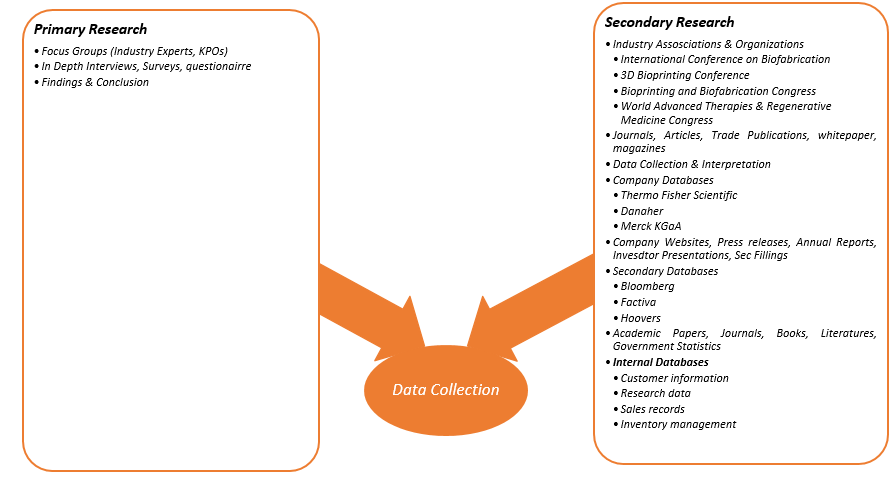
After collecting data from secondary and primary sources, we carefully examine the following to establish base numbers:
- Analyzing company revenues and their corresponding market share (involving the analysis of revenue data released by publicly listed manufacturers)
- Deriving market estimates by inspecting the primary market as well as its complementary markets
- Presenting key findings based on major segments and outlining top strategies by major players
- Analyzing the dynamics of the market, including drivers, opportunities, restraints, and challenges
- Assessing macro-economic factors and the regulatory framework influencing the market
- Evaluating market investment feasibility, conducting PEST and PORTER’s Five Force analyses
- Performing impact analysis of drivers and restraints, and conducting industry chain and cost structure analyses
- Creating opportunity maps, analyzing market competition scenarios, and conducting product life cycle analysis
- Identifying opportunity orbits and manufacturer intensity maps
- Analyzing major companies’ sales by value to gain comprehensive insights into the market
Market Sizing & Forecasting
We use both bottom-up and top-down approaches to segment and estimate quantitative aspects of the market. Our research reports also present data triangulation, which examines the market from three different perspectives.
- In the Bottom-Up Approach, we begin by collecting data at the micro-level, which includes individual data points and small samples. We aggregate and analyze the data to form broader conclusions and insights. We also include the market share of the vendors, which provides a granular view of the key players in the market, starting from the ground up. This approach is useful for industries with diverse segments and varied customer preferences. It is effective in exploratory research when we have little pre-existing knowledge and allows unexpected patterns and trends to emerge from data, leading to the creation of new theories.
- In the Top-Down Approach, we start with a macro-level view of the market, including the overall market size and industry trends. We analyze large-scale data and market indicators to make general assumptions. This approach provides a broader perspective and identifies the main market drivers and trends. We then narrow down the focus as data is scrutinized and specific segments are explored. This approach is effective for quickly assessing overall market potential and opportunities in various regions.
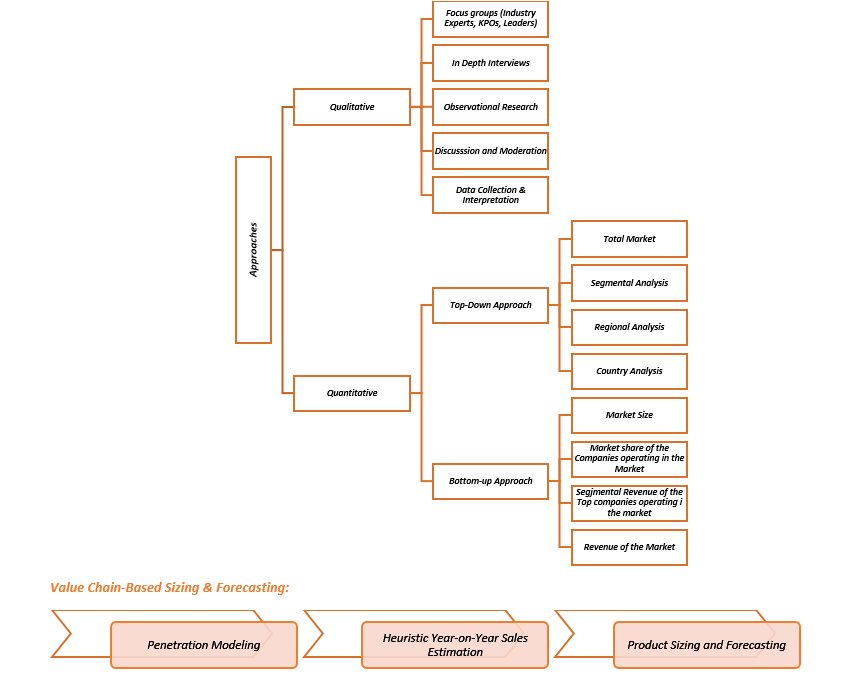
Value Chain-Based Sizing & Forecasting:
Consumer Behavior:
- Usage Rates and Patterns: Collect and analyze data on current product usage. It assists in product development and marketing strategies. Moreover, it also helps determine substitute rates.
- Market Penetration by User Base: Estimate the total market size and assess success in engaging potential consumers. Identify unmet needs and growth opportunities to enhance market penetration.
- Analyze market share, customer satisfaction, and preferences, providing insights into competitive positioning.
Historical/Empirical Data:
- Establish baseline estimates for analyzing future trends and making informed decisions.
- Use exponential smoothing to predict future product performance by accounting for trends and patterns over time.
Trend Analysis:
Conduct trend analysis using year-trending models to study historical data and identify patterns and trends that can influence future product penetration. This analysis aids in making proactive decisions and adapting strategies to capitalize on emerging opportunities and overcome challenges in the market.
Data Validation:
- Engage with in-house market analysts and industry experts to validate all collected data and cross-check it through calls or face-to-face interviews.
- Conduct thorough quality checks to validate the data included in the report and contact various members of our network to verify the data’s authenticity, resulting in error elimination and eradication of doubtful information.
- Correlate with standard KIPs to gain insights into future trends.
- Conduct multi-tier data validation through external thought leaders, market analysts, subject matter experts, comparative analysis, and review data collection instruments.
Continuous Monitoring: Final Report and Presentation
- Our team collaborates with industry experts to finalize and validate data. We utilize advanced data analysis models to generate valuable insights. Our integrated report comes with robust analytics and advanced visualization capabilities to ensure consistency and efficiency. We implement a standardized content management approach, common tagging, and taxonomy structure for seamless information connectivity. We offer comprehensive market and company views to facilitate easy and accurate comparisons. Our goal is to provide our clients with exceptional analytical resources for a competitive edge. We empower them to transform data into strategic insights for innovation and growth.
